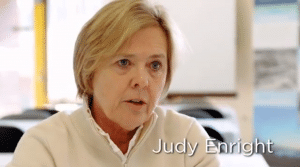How Many Conversations?
CompetencyWorks Blog
 Systems consultant Judith Enright, in the Maine Center for Best Practice video on the Western Maine Education Collaborative, reminds us, “change happens one conversation at a time.” It’s a truism, of course, but in our work promoting competency-based learning, it has met its moment. Again and again – in the case study work I’ve done, or in my own experience talking to teachers, parents and education leaders – I find that the real work of cultural transformation occurs when one person talks to another honestly, and a relationship is forged. One conversation at a time.
Systems consultant Judith Enright, in the Maine Center for Best Practice video on the Western Maine Education Collaborative, reminds us, “change happens one conversation at a time.” It’s a truism, of course, but in our work promoting competency-based learning, it has met its moment. Again and again – in the case study work I’ve done, or in my own experience talking to teachers, parents and education leaders – I find that the real work of cultural transformation occurs when one person talks to another honestly, and a relationship is forged. One conversation at a time.
Which means a lot of conversations.
A colleague of mine once gave a talk to 350 faculty, and, afterward, five teachers approached him. He talked with each one, working with them to relate the general ideas of his talk to the specific circumstance of their classrooms. This wasn’t because these five teachers couldn’t have made the cognitive connections on their own, or because they needed to be spoon fed, or because they needed to have their own personal complaints validated by “the expert.” They were suspicious. They didn’t “get it”– in the sense that they weren’t convinced. They needed the conversation to move forward in this learning and this work. They are not unusual. This is not evidence of a “problem.” This is a normal part of the change process.
Learning has an affective element to it – we all know this – especially learning around issues of value. Folks being asked to learn a new way of conceptualizing fundamental truths of their work, lives, and profession need to be able to sort through the knotty “yeah, buts” and “that’s crazy” and “what does that mean” and “this is frightening” and “don’t tell me I’ve been doing it wrong all this time.” The person who could encounter these issues without having a conversation (or a hundred) would, by my reckoning, be quite rare. People need to have these conversations, and we have to be willing to have them.
How many conversations?
That’s the question that comes up when the “change happens one conversation at a time” line is deployed — and it’s a valid one. At the Nellie Mae Learning 2030 Conference in Wellesley, MA, I found myself intruding into a conversation discussing this very thing. How many conversations do we have to have? Is there a way to foresee the workload we’re taking on? One of the conversants referred to my case study work. What had I found?
In all of the districts I’ve studied, even those that have been at this for years, the conversations continue to be ubiquitous and ongoing. The change began with conversations – in leadership teams, at conferences, in faculty meetings, in the teacher’s room, in professional development, in the hallway, in the parking lot – and the conversations don’t ever slow down. For these districts, conversation isn’t a way of learning a thing, figuring it out, or solving it. A conversation might end, but conversation does not. It’s a way of negotiating complex situations and relations – and there are always complex situations and relations to negotiate. Conversation is a way for an organization to be and thrive in a complex world. It is what drives a district to a culture of continuous improvement.
This, of course, dodges the question of the conversants at Wellesley. Once you start the conversations – if you embrace this work – the conversations don’t stop. But even assuming the conversation will continue on without us, at what point can we say, as change agents, “Our work here is done? We have made the change?” There is no easy answer.
Ronald A. Heifetz, in his masterpiece entitled (appropriately enough) Leadership Without Easy Answers, captures this dilemma better than any writer I’ve read. Any educational leader advocating the shift to competency-based learning would do themselves an enormous favor in reading it. There will come a time when a school can be said to have “become” a competency-based system – or, in Heifetz’ examples, the Civil Rights Act will pass, or troops will be withdrawn from Vietnam – but it’s impossible to mark that moment in advance. Until it happens, the educational leader is compelled to keep the conversation going. Until the conversation is done, don’t make decisions that foreclose possibilities. Don’t act in a way that drives folks away from the conversation. Don’t allow folks the opportunity to abstain from the conversation. As leader, you can frame the conversation (“Identify the adaptive challenge”), you can regulate distress, you can direct attention to the specific issues that need it, but, sooner than later, you have to give the work back to the people living the change.
Change happens one conversation at a time. There are many conversations. The people living the change have to have those conversations.
Gary Chapin is a Senior Associate at the Center for Collaborative Education.